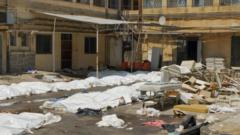Amid rising tensions in southern Syria’s Druze-majority province of Suweida, horror stories are emerging from the National Hospital regarding alleged massacre claims. Reports indicate Syrian government forces have attacked the hospital in what witnesses describe as a brutal raid targeting members of the Druze community amid sectarian violence.
Describing the scene, Dr. Wissam Massoud, a neurosurgeon at the hospital, labeled the event a "massacre," stating that soldiers had entered with the pretext of enforcing peace but instead murdered patients who were defenseless in their hospital beds. He issued a chilling video showing the aftermath of the attack, in which lifeless bodies are seen covered in bloodied sheets.
Hospital volunteer Kiness Abu Motab echoed these sentiments, questioning the motives behind the violence, stating, "What is their crime? Just for being a minority in a democratic country?" Eyewitness accounts, including that of local English teacher Osama Malak, revealed that even children were not spared from the brutality, with reports of an eight-year-old disabled boy shot in the head.
While the complexities of the conflict lead to mutual accusations of atrocities among various stakeholders, the immediate concern centers around the safety of civilians and the unprecedented violence directed towards them. The Syrian defense ministry has acknowledged reports of grave violations but calls for thorough investigations into these allegations remain uncertain.
Access to Suweida has been significantly limited, complicating efforts to gather firsthand evidence. Amid checkpoints and military presence, the city has become a battleground with clear signs of conflict, including burned structures and scattered debris. Despite recent attempts by the Syrian government to impose a ceasefire, the tension simmers as various factions struggle for control.
As the chaotic situation evolves, the plight of innocent victims continues to draw attention. Eight-year-old Hala al-Khatib, one of the casualties, was found bloodied and bandaged, having sustained a severe injury while hiding during the attack. Tragically, she is now left to grapple with the loss of her parents, an all too common reality in this war-ravaged area where the horrors of sectarian conflict manifest in the most devastating ways.
Describing the scene, Dr. Wissam Massoud, a neurosurgeon at the hospital, labeled the event a "massacre," stating that soldiers had entered with the pretext of enforcing peace but instead murdered patients who were defenseless in their hospital beds. He issued a chilling video showing the aftermath of the attack, in which lifeless bodies are seen covered in bloodied sheets.
Hospital volunteer Kiness Abu Motab echoed these sentiments, questioning the motives behind the violence, stating, "What is their crime? Just for being a minority in a democratic country?" Eyewitness accounts, including that of local English teacher Osama Malak, revealed that even children were not spared from the brutality, with reports of an eight-year-old disabled boy shot in the head.
While the complexities of the conflict lead to mutual accusations of atrocities among various stakeholders, the immediate concern centers around the safety of civilians and the unprecedented violence directed towards them. The Syrian defense ministry has acknowledged reports of grave violations but calls for thorough investigations into these allegations remain uncertain.
Access to Suweida has been significantly limited, complicating efforts to gather firsthand evidence. Amid checkpoints and military presence, the city has become a battleground with clear signs of conflict, including burned structures and scattered debris. Despite recent attempts by the Syrian government to impose a ceasefire, the tension simmers as various factions struggle for control.
As the chaotic situation evolves, the plight of innocent victims continues to draw attention. Eight-year-old Hala al-Khatib, one of the casualties, was found bloodied and bandaged, having sustained a severe injury while hiding during the attack. Tragically, she is now left to grapple with the loss of her parents, an all too common reality in this war-ravaged area where the horrors of sectarian conflict manifest in the most devastating ways.
















